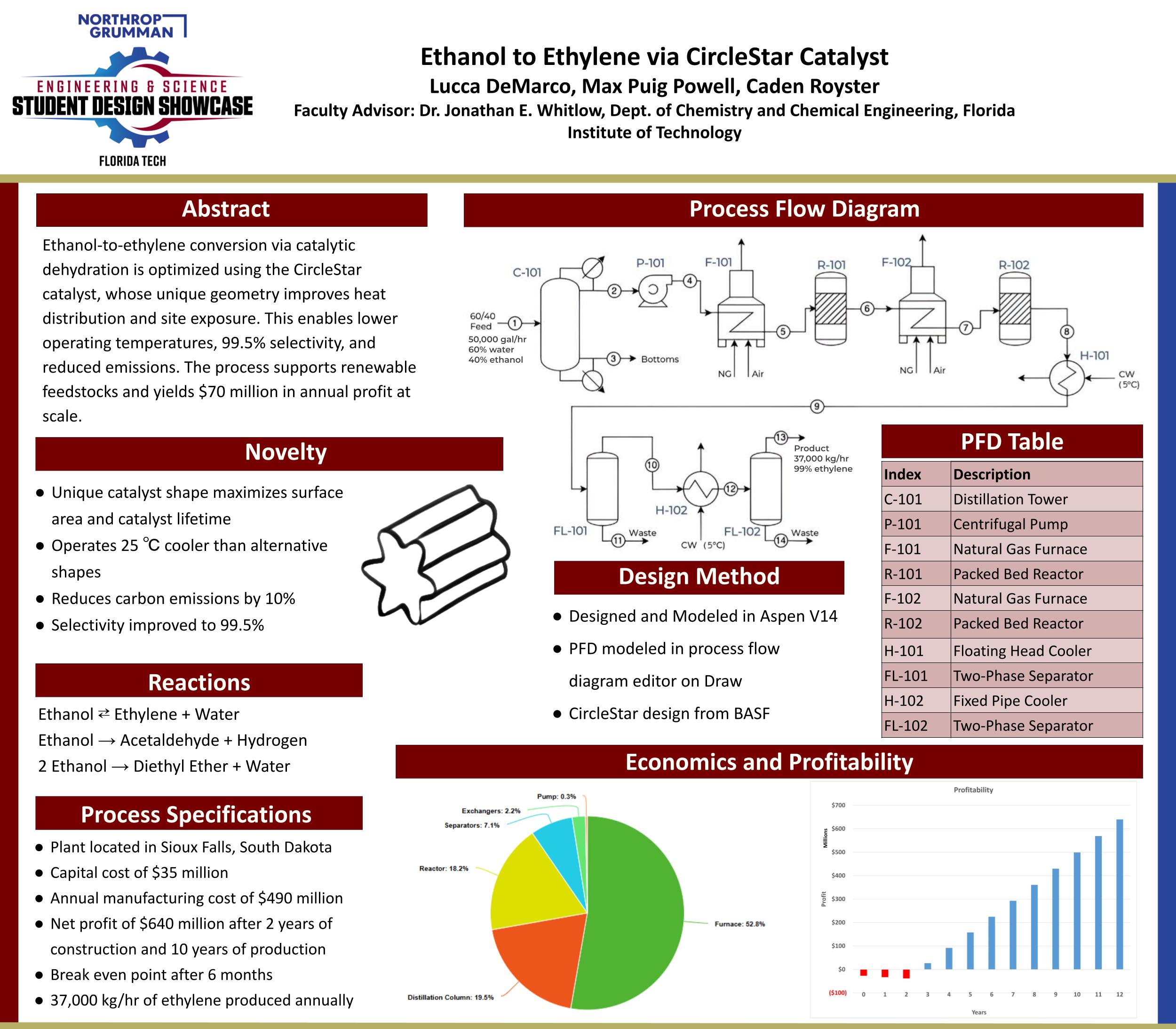Project Summary
This senior design project proposes an innovative process for the production of acetylene gas (C2H2) by utilizing carbon dioxide (CO2), water (H2O), and calcium carbide (CaC2) through a sequence of reactors and separators. A key advancement of this process is repurposing carbon dioxide emissions from flue gas, aligning with sustainability and carbon capture initiatives. The method involves the electrochemical reduction of carbon dioxide in a high-temperature molten salt reactor with calcium oxide (CaO) to produce CaC2 and oxygen (O2). The CaC2 is subsequently hydrolyzed in a continuous stirred-tank reactor (CSTR) to generate acetylene gas and calcium hydroxide (Ca(OH)2), followed by purification steps to ensure the production of high-purity C2H2.
The CO2 required for this reaction is sourced from coal-fired power plant flue gas located in Tatum, Texas, which typically contains 8-10% CO2 by volume. A separation technique using monoethanolamine (MEA) absorption is selected as the optimal method for carbon dioxide capture. This process assumes a 66% carbon capture efficiency and 70% acetylene conversion, leading to an estimated production rate of 1,400 kmol/hr of acetylene and an annual output of approximately 308,000 metric tons. Concurrently, the system captures 4,300 kmol/hr of carbon dioxide, translating to 1.5 million metric tons annually.
Acetylene is a well-established industrial commodity valued at $3.7 billion in 2023, with a projected compound annual growth rate of 5.4%, expected to surpass $5 billion by 2030. It is extensively utilized in welding and cutting operations, chemical synthesis, portable lighting, and steel manufacturing. Additionally, valuable byproducts such as oxygen, calcium hydroxide, and calcium oxide hold significance in industries including wastewater treatment, pharmaceuticals, and plastic production.
Process modeling and simulation are conducted using Aspen Plus, incorporating black-box representations for critical reaction steps due to the challenges associated with simulating solid-phase reactions such as CaC₂ hydrolysis. Sensitivity analyses are performed to assess reaction conditions, separation efficiencies, and overall economic viability. The process leverages a sustainable feedstock approach by utilizing waste CO₂, thereby reducing greenhouse gas emissions and supporting circular carbon economy principles.
This project highlights the feasibility of a scalable and environmentally sustainable acetylene production process, providing an alternative to conventional fossil fuel-based methods while meeting industrial demands for high-purity acetylene gas. This plant is expected to be extremely profitable, with a projected net profit of $127,000,000 per year.
Project Objective
The objective of this project is to design a sustainable and economically viable process for producing high-purity acetylene gas (C₂H₂) using waste carbon dioxide (CO₂), water, and calcium oxide (CaO). By repurposing CO₂ from coal-fired power plant flue gas, the process reduces emissions through electrochemical conversion, hydrolysis, and separation. This approach offers a carbon-negative alternative to conventional acetylene production while meeting industrial demand and ensuring profitability.
Manufacturing Design Methods
The acetylene production process was modeled using Aspen Plus, with black-box representations for key units like the molten salt reactor and CSTR due to solid-phase reaction complexities. Standard equipment was sized based on process conditions, fluid properties, and heuristics from Appendix G. Design assumptions included 66% CO₂ capture and 70% acetylene conversion. Capital and manufacturing costs were estimated using Turton’s method, adjusted for 2025 using CEPCI values. This approach ensures a sustainable, cost-effective, and scalable process.
Specification
The acetylene production process uses flue gas containing 8–10% CO₂ from a coal-fired power plant in Tatum, Texas. CO₂ is captured using monoethanolamine (MEA) at 38–50 °C and 2.24 atm, with a 66% capture efficiency. In the molten salt reactor operating at 550 °C, CO₂ reacts with CaO to form CaC₂, which then undergoes hydrolysis in a CSTR to produce acetylene and Ca(OH)₂. Calcium oxide is regenerated from Ca(OH)₂ at temperatures above 512 °C. The process achieves 70% acetylene conversion, producing 1,400 kmol/hr (308,000 metric tons/year) of acetylene and capturing 4,300 kmol/hr of CO₂. Key equipment includes heat exchangers, pumps, compressors, heaters, and distillation columns, all designed based on Aspen Plus simulations and standard design heuristics.
Analysis
The final report presents a well-designed and innovative process for sustainable acetylene production by converting CO₂ emissions from flue gas into valuable products. Using Aspen Plus simulation and black-box modeling for complex reactions, the team effectively outlines process design, equipment sizing, and economic analysis. The plant demonstrates strong financial viability, breaking even in three years with a 52.1% IRR when capturing CO₂. The report also emphasizes environmental compliance, safety, and efficient resource recycling. While some assumptions, such as high recycling efficiencies and manual electrode replacement, may limit scalability, the overall design is both technically sound and economically promising.
Acknowledgement
We would like to sincerely thank Dr. Jonathan E. Whitlow for his guidance, support, and expertise throughout our senior design project. His insight and encouragement were instrumental in helping us develop a process that is both innovative and practical. We are grateful for his time, mentorship, and dedication to our success.
![]()


